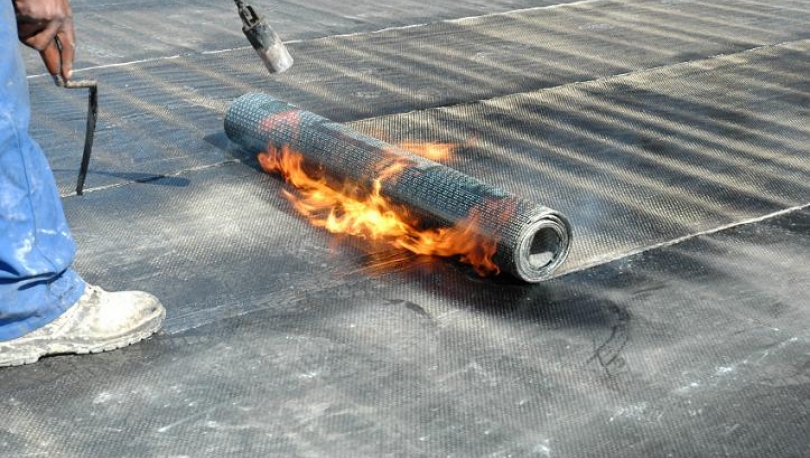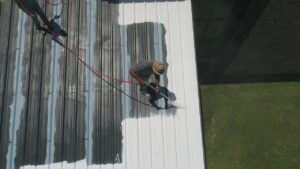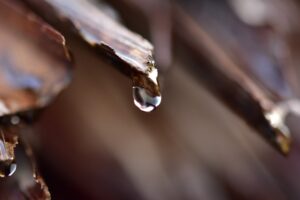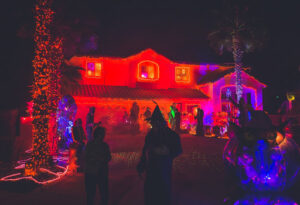
HOT TAR ROOFING
Our multi-layered hot tar roofing systems continue to be a reliable and long-lasting method for waterproofing flat and low sloping roof structures. Over the years many roofing systems have come and gone, but the hot tar built-up roofing system remains a constant in our industry. This old technology coupled with advances in material manufacture make the hot tar built-up roofing system the most widely used roofing system to date.
PROS: Well proven, long lasting, easy to build up low spots, above average warranty.
CONS: Tar smell during installation, more equipment and labor needed.
MODIFIED BITUMEN: (RUBBERIZED-TORCH SYSTEM)
Polyester reinforced APP membranes are designed for direct flame heat welded applications. Commonly known as “Torch” roofing systems, they are liked by many roofing professionals for their straightforward application and ease of installation. These roof systems achieve a watertight seal by applying a direct flame onto the roof membrane and melting a bituminous layer that is embedded within the roll itself; thus creating a waterproof seal.
PROS: Easy installation, less equipment and labor, flexible, no tar smells.
CONS: Fire hazard due to use of a direct flame on the roof, very easy to install incorrectly.
SELF ADHESIVE ROOFING: (SA SYSTEM)
Self-adhesive SBS and APP roof membranes are a new concept to roofing which incorporates the best of most existing built-up roof membranes and eliminates some of their shortcomings. These systems offer great warranties without the need for hot tar equipment or a direct flame over your roof. This new technology has developed for use in flat and some sloped roof structures. The concept has been called “Peel and Stick” which basically describes its simplicity.
PROS: No hot tar or fumes, no direct flame, cleaner, greater warranty, less equipment.
CONS: New and not as proven, higher priced.
SINGLE PLY: (TPO, PVC)
Considered by many roofing experts as the future of roofing systems. These systems have been in development for over 30 years. Thermoplastic Olefin, (TPO) sheets are a blend of polypropylene and ethylene propylene polymers and are reinforced with polyester. TPO sheets contain a colorant, flame retardants, UV absorbers and other proprietary substances to achieve desired physical properties. Polyvinyl Chloride (PVC) is typically reinforced with polyester or glass-fiber mats commonly referred to as scrim. PVC sheets contain plasticizers and stabilizers, as well as other additives to impart flexibility and achieve other desired physical properties. Some membranes are available with nonwoven fleece backing adhered to the underside of a sheet. These membranes can be repeatedly softened by heating or hardened when cooled. Because of the materials’ chemical nature, thermoplastic membranes typically are seamed by heat welding with hot air or solvent welding.
PROS: Durable, lightweight, no hot tar odor, clean installation, no direct flame, greater warranty.
CONS: High priced, easy to puncture.
SHINGLE ROOFING: (COMPOSITION SHINGLE)
Nowadays the most popular choice for roofing material is the composition roof shingle, especially if you can’t afford the high cost of clay tile or slate roofs. Higher-quality versions made from asphalt or fiberglass shingles offer a more durable option and may be available with recycled content. The advantage of these roof shingles is that they are quite budget-friendly. Apart from this, they are also available in a wide variety of styles and colors and thus you have a lot of options to choose from. They are relatively easy to install, require low maintenance and can be walked on without damaging the material. Most brands offer Class “A” fire protection.
PROS: Affordable, many styles available, long lasting, low maintenance, Class “A” fire retardant.
CONS: Poorly imitate wood shingle and shake, transfer more heat than clay, stone or wood.
SLATE ROOFING: (STONE SLATE)
Actual shingle-like slivers of rock, slate is a natural roofing material that shows up in more upscale homes. Slate is another roofing material that is long lasting and near indestructible if not walked on. Although slate is an expensive choice, it offers a very natural look and can be laid out in a variety of patterns. Natural slate roofs have been known to last hundreds of years and are often considered the best type of roofing.
PROS: Longest lasting, low maintenance, Class “A” fire retardant, authentic natural look, non-fading, resists most forms of weathering, insects and rot.
CONS: High priced, can be heavy and structural reinforcement is commonly necessary, can be broken if not carefully walked on.
COOL ROOF COATINGS
Cool Roof coatings have steadily become a more popular form of protection against the elements over the last few years, mainly because Cool Roofs can deliver high solar reflectance and high thermal emittance (the ability to radiate absorbed or non-reflected solar energy). These systems can be sprayed on or rolled on to your roof like most paint. These acrylic elastomeric or silicone based coating can be much ticker and full-bodied than your normal paint and deliver performance that will definitely outperform your everyday standard paint products. These systems can be used in conjunction with cold applied liquid emulsion and fiberglass matting to provide a complete roofing system without the need for old roof removal.
PROS: Less than half the price of a complete new BUR roof, provides you with a warranty close to that of most basic built-up roof systems, extend the roof service life and achieve cooling energy savings in hot summers. No roof removal required, less debris, no smell of tar, no direct flames on the roof. Easy and fast application.
CONS: Without a proper maintenance program to keep the material clean, the energy savings of cool roofs can diminish over time. They are thin and do not as long lasting as a BUR (built-up roofing system). In open beam homes or structures with no attic space or insulation, they can make for a colder winter. They have to be re-coated every 8-12 years.





